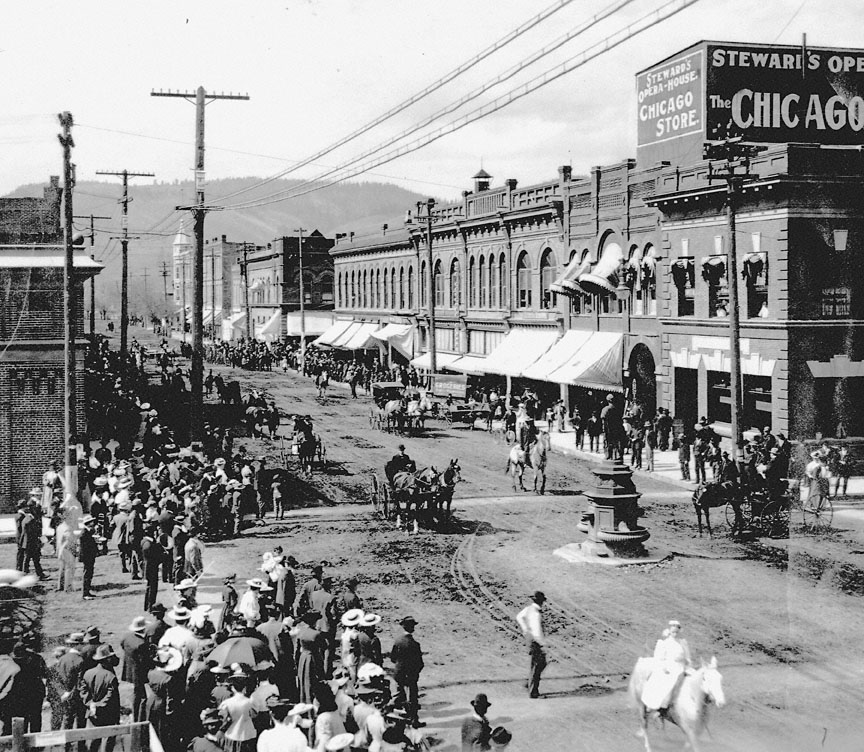- Catalog No. —
- CN 010001
- Date —
- 1908
- Era —
- 1881-1920 (Industrialization and Progressive Reform)
- Themes —
- Geography and Places
- Credits —
- Oregon Historical Society
- Regions —
- Northeast
- Author —
- Unknown
Crowds Line Downtown LaGrande Streets, 1908
The intersection of Elm Street with the principal commercial artery of La Grande, Adams Street, appears in this 1908 photograph. There is a crowd and a procession of horse-drawn carts, but the occasion is not known.
The agricultural promise of the Grande Ronde River Valley was noted by immigrants on the Oregon Trail in the 1840s. Some settlement occurred in the 1850s, and the community of La Grande emerged in the 1860s. The settlement prospered with the arrival of the Union Pacific Railroad in 1884, and it became an important railroad division point. Its maturity as a regional trade center and county seat is apparent in this photograph of a bustling retail street lined with two-story brick buildings, most of them displaying the Italianate style of architecture popular in the 1880s. The brick was locally produced by the La Grande Brickyard, a company founded in 1865 that survived for more than a century The wall advertising the Chicago Store is part of Stewart’s Opera House, a theater located within the block; the tall space over the stage, known as the flies, housed the apparatus for the theater’s curtains, scenery, and lighting.
The fountain, designed for horses as well as people, was dedicated on September 7, 1904, by the town’s chapter of the Women’s Christian Temperance Union (WCTU). Local WCTU groups often erected public fountains as part of their effort to discourage the use of alcoholic beverages. This statue was of an unspecified woman; though she was officially named “Temperance,” the citizenry called her “Cast Iron Mary.” When Adams Street was paved in 1912, “Mary” was moved a few blocks to 4th and Depot Streets, where she stood until she was demolished by an errant carload of bootleggers one night in 1922. A replica was recently erected on Adams Street, based on historical photographs.
The downtown streetscape of La Grande in the early 1900s was similar to that of many Oregon towns and cities along the railroad lines, such as Ontario, Pendleton, Hood River, Albany, Roseburg, Grants Pass, and Medford. Some of these towns could boast of a theater such as Stewart’s Opera House, where drama troupes traveling by train might stop for a one-night performance en route to larger markets such as Portland. Nor was “Temperance” unique; Roseburg hosted a statue of the Greek goddess Hebe, also sponsored by the WCTU, which graced a downtown intersection until it was toppled by a team of runaway horses in 1912.
Further Reading:
Hermens, Richard A., and John E. Turner. La Grande, 1885-1985. La Grande, Oreg,: 1985.
Norman, James J., Jr., with Rosalind Clark Keeney. Oregon Main Street: a Rephotographic Survey. Portland, Oreg., 1994.
Related Historical References:
National Register of Historic Places: Oregon—Union—La Grande Commercial Historic District (District - #01000933). Roughly bounded by Union Pacific Railroad tracks along Jefferson St., Greenwood and Cove Sts., Washington St., & Fourth St., La Grande.
Written by Richard Engeman, © Oregon Historical Society, 2005.
